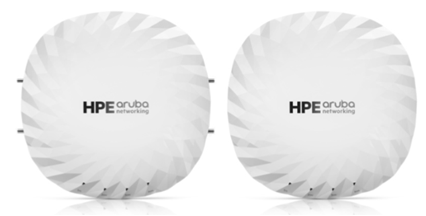HPE Aruba Networks Launches Wi-Fi 7 AP with external directional antennas for high density & manufacturing applications

Today, HPE Aruba Networks launched its newest Wi-Fi 7 APs, the AP-735 and AP-734. With support for external antenna options, the AP-734 makes it easy to design and deliver great 6 GHz Wi-Fi services everywhere—particularly in high-density environments like auditoriums, convention centres, airports, or manufacturing. The APs deliver close to 14 Gbps of data with a 2x increase in the number of IoT devices that could be connected, as stated by HPE. Dual 5 Gbps Ethernet supports backhaul connectivity. The unit is the first of its kind in the industry.
The FCC restricted the use of external, removable directional antennas until an active AFC program was in place, allowing standard power (SP) operation. Wi-Fi practitioners finally have an option to granularly focus RF energy where they want it and not blast RF in unneeded directions when using 6 GHz with Wi-Fi 6E and Wi-Fi 7.
Enter HPE’s new Wi-Fi 7 access points, designed to deliver more functions and go beyond releasing a product with merely a generational increase. These Wi-Fi 7 capable APs support staple features like 2x channel width (up to 320 MHz), MLO, static puncturing, and 4K-QAM. HPE also recognizes that IoT is becoming more integral to enabling business outcomes. Estimates predict that 55.7B devices will be connected by 2025, with 75% of those connecting via an IoT platform.
To enable this IoT connectivity, the AP-730 supports BLE 5.4 (with HADM), 802.15.4/zigbee, and dual USB ports. APs are also equipped with larger CPUs and additional memory to support local containers for IoT applications to take advantage of the many IoT radio options. While also supporting dual USB ports to add future IoT radios (think LoRaWAN, HaLow, Thread, EnOcean…), the APs can be configured as follows:
- BLE 5.4 (with HADM) + BLE 5.4, or
- BLE 5.4 (with HADM) + 802.15.4/zigbee
Flexible radio configuration enables Wi-Fi practitioners to manage co-channel interference better while balancing coverage. The tri-band radio can be deployed in the following configurations:
- 5 GHz + 6 GHz + 6 GHz
- 5 GHz + 5 GHz + 6 GHz
- 2.4 GHz + 5 GHz + 6 GHz
The upper 5 GHz and lower 6 GHz band butt up right beside each other with potential for interfering bleed. To counter this, patented ultra tri-band (UTB) dynamic filtering prevents signal bleedover. Traditional bandpass filters need about 200 MHz of separation between channels, according to HPE. UTB filtering intends to save the potential 160 MHz of lost spectrum in the lower portion of 6GHz.

While advantageous, I wonder why the same patented technology was not used to isolate neighbouring radios within the same band, such as dual 5 GHz or dual 6 GHz deployments. With dual 5 GHz, the 5340-5480 MHz band is blocked off, and with dual 6 GHz, UNII-6 is unavailable.
Increasing accuracy for location services is achieved from 2 meters to sub-1 meter resolution. APs are equipped with GPS receivers & barometric sensors to measure latitude, longitude, and altimeter. Location information (LCI) can be broadcast via Wi-Fi radios using 11az (the upgrade to 11mc) or advertised via BLE to enable small asset tracking, proximity, wayfinding, and more…
Although immediately there may not be strong use cases for this flexible connectivity, product management took a page from the Field of Dreams playbook: Build it, and they will come.
At this point, you may think these APs need a lot of power to drive all those radios and adapters, and you’re not wrong. The max power draw is 24W, but HPE put a lot of thought into responsible power management, developing an AI-powered dynamic power-saving mode. This feature reduces energy consumption by transitioning APs into an idle or deep sleep state in which they consume 12W or 2W, respectively. This is a step in the right direction if sustainability matters to your organization or you lay awake at night worried about the energy crisis.
Such behaviour may catch the attention of those who fight the battle against aggressive channel or transmit power changes, which reduce the stability of a WLAN — leading to negative user experiences. Transitioning from active to deep sleep (or vice versa) takes a few minutes, but a WLAN properly designed with overlapping secondary coverage could easily disable half the access points during periods of low connectivity without significant impact on client experience. Features like 802.11v could gracefully migrate clients away from APs about to transition into a deep sleep.
I should also add that while the Wi-FI 7 AP-730 supports 320 MHz channels, HPE does NOT recommend using 320 MHz wide channel widths in Enterprise deployments due to the lack of channel reuse.
The AP-735 and AP-734 will be orderable in June, with expected shipping dates in July. Multiple antenna options will be available, or you can contact your favourite third-party antenna provider, who already have options available.
Slàinte!
Resources
HPE Aruba Networking 730 Series Campus Access Points Data Sheet
https://www.arubanetworks.com/resource/730-series-campus-access-points-data-sheet
HPE Aruba Networking’s Integration of Wi-Fi 7 Technology
Introducing Wi-Fi 7 access points that deliver more
https://blogs.arubanetworks.com/solutions/introducing-wi-fi-7-access-points-that-deliver-more
The Wi-Fi 6E challenge: Bridging the (small) gap between 5 GHz and 6 GHz with ultra try-band filtering
https://blogs.arubanetworks.com/industries/the-wi-fi-6e-challenges-6-ghz-ultra-tri-band-filtering